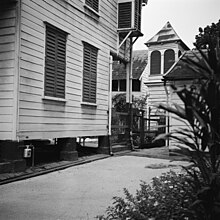Grote Stadskerk
| Grote Stadskerk | ||
|---|---|---|
Mamakerki | ||
Year consecrated 21 July 1828 | | |
| Location | ||
| Location | Paramaribo, | |
| Geographic coordinates | 05°49′31″N 55°09′39″W / 5.82528°N 55.16083°W | |
| Architecture | ||
| Groundbreaking | 21 July 1827 | |
| Specifications | ||
| Length | 30 m (98 ft) | |
| Width | 19 m (62 ft) | |
| Materials | wood | |
Grote Stadskerk (Sranan Tongo: Mamakerki[1]) is a church of the Moravian Church. It is located on Steenbakkerijstraat in the historic centre of Paramaribo, Suriname.[2] The building is a monument.[3] The Grote Stadskerk is the first, and the largest church of the Moravian congregation in Suriname.[4]
History
The
Building
On 27 February 1767, an office for the mission was built on Steenbakkerijstraat. The attic was used as a church, but soon became too small for the congregation. On 31 May 1778, a first church was inaugurated on the site where the Grote Stadskerk now stands.[4] By 1827, the decision was taken to build a completely new church to accommodate the growing numbers of church members. The foundation stone for this was laid on 21 July 1827. The consecration of the finished building took place on 21 July 1828.[4] The building was enlarged several times during the 19th century, and reached its current size in 1847.[2]

The church is 30 metres (98 ft) long and 19 metres (62 ft) wide. The rear façade has very large
Initially, the church did not have its own cemetery. Between 1767 and 1776, fifteen missionaries and children were buried behind the church. In 1851, a memorial was placed at the site.[7]
The congregation of the church consisted mainly of slaves and
References
- ^ Heinrich E. Helstone (2002). "Daniel Petrus Yveraar 1848–1905". OSO. Tijdschrift voor Surinaamse taalkunde, letterkunde en geschiedenis (in Dutch). Retrieved 11 March 2021.
{{cite magazine}}: Cite magazine requires|magazine=(help) - ^ a b c d e "Grote stadskerk EBG, Steenbakkerijstraat 21". City of Paramaribo (in Dutch). Retrieved 11 March 2021.
- ^ "Monumentenlijst (2014)". City of Paramaribo (in Dutch). Retrieved 11 March 2021.
- ^ a b c d e f "EBG 275 jaar in Suriname". Suri Church (in Dutch). Retrieved 11 March 2021.
- ^ H.G. Steinberg (1933). Ons Suriname (in Dutch). p. 12. Retrieved 11 March 2021.
- ^ "The Dutch Colonial expansion in the West (4–17)". Suriname.nu. Retrieved 11 March 2021.
- ^ "EBG in Paramaribo". Werkgroep Caraibische Letteren (in Dutch). Retrieved 11 March 2021.
- ^ H. Algra & A. Algra (1956). "Dispereert niet. Part 5". Digital Library for Dutch Literature (in Dutch). p. 303. Retrieved 11 March 2021.
- ^ "Definitieve Resultaten Achtste Algemene Volkstelling (Vol. I)" (PDF) (in Dutch). p. 39. Archived from the original (PDF) on 24 September 2015. Retrieved 11 March 2021.


